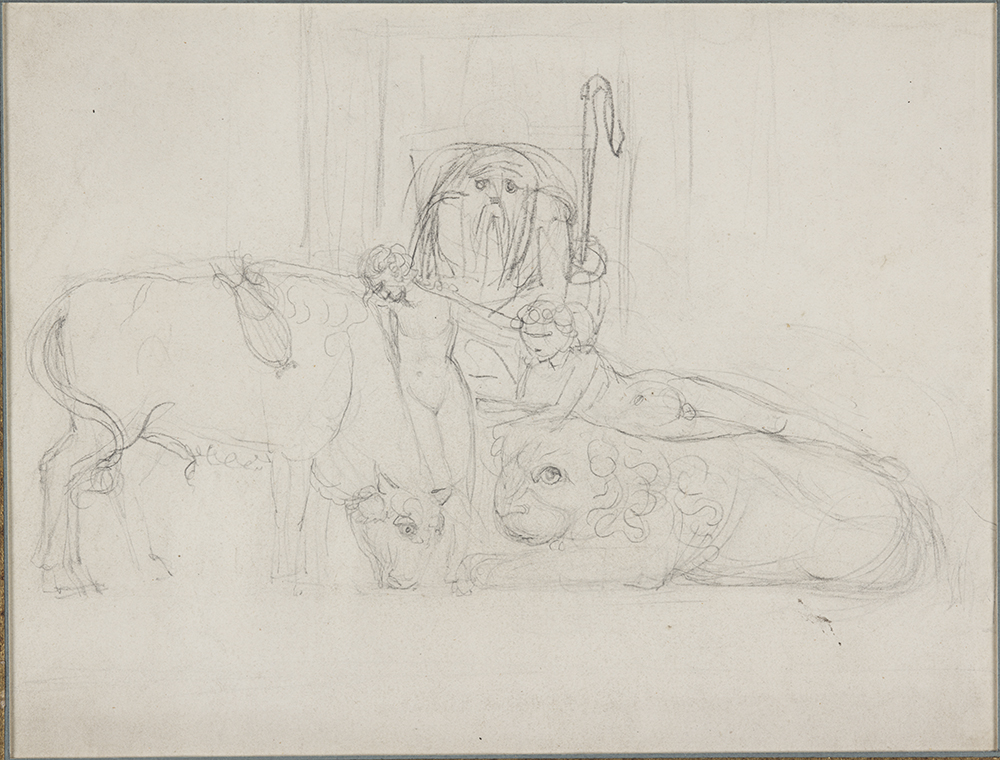
2. The Lion Lying Down with the Ox. Pencil on wove paper, leaf 20.5 x 26.7 cm. Butlin #226 verso. Essick collection. For the recto drawings, see illus. 1.
Geoffrey Keynes offers an interesting reading of this vigorous, and evidently symbolic, sketch in Drawings of William Blake: 92 Pencil Studies (New York: Dover, 1970), caption to illus. 5. He associates the drawing with a line from Blake’s Tiriel, “Why is one law given to the lion & the patient Ox” (E 285), and states that “it is clearly a tentative idea for an illustration” to that poem of c. 1789. Although the object held by the hunched-over old man in the background is probably a shepherd’s crook, Keynes describes it as a whip, the instrument by which this Urizenic figure enforces “one law” for all. Butlin modifies this interpretation in several important respects. He dates the drawing to c. 1790-95, largely for stylistic reasons, notes the similarities, in sensibility and possibly in iconography, to America pl. 9 of 1793, and points out that Blake used a revised version of the line from Tiriel in The Marriage of Heaven and Hell of 1790: “One Law for the Lion & Ox is Oppression” (E 44).
As Keynes suggests, the youthful male lying on the lion may be holding and reading a book; the standing (prepubescent?) female holds a lyre in her extended right hand. The foreground creatures may be the inhabitants of a peaceable kingdom where harmony resides between the lion and the ox, humans and animals, male and female, music and the written word. The design thus accords with Isaiah 11:6-7, a millenarian vision of a time when “the wolf also shall dwell with the lamb … and the lion shall eat straw like the ox.” Given this perspective, the old man can be viewed as a threat emerging into this Edenic state rather than a sign of its present condition. He may be a priest, the shepherd of a human flock. His blankly staring eyes may be blind, or at least incapable of imaginative visions such as the one in front of him. The lightly sketched rectilinear forms around him, perhaps representing a portal through which this figure has entered the scene, reinforce his contracted posture and contrast with the curving lineaments of life. Even if he holds a crook rather than a whip, the rod still suggests imposed control in the hand of a menacing counterpart to the benign shepherds in Blake’s art and poetry.
Another textual analogue for the drawing’s major motifs, probably composed at about the same time as this drawing and its recto sketches, can be found among Bromion’s questions in Visions of the Daughters of Albion (1793):
And are there other joys, beside the joys of riches and ease? And is there not one law for both the lion and the ox? And is there not eternal fire, and eternal chains? To bind the phantoms of existence from eternal life? (E 48)
The foreground in the drawing offers a positive contrary to Bromion’s negative rhetoric and perspective: there are “joys” other than “riches and ease,” the lion and ox need not be harnessed to the same law to reside in peace, and such visions are not mere “phantoms.” Unfortunately, the old man may soon “bind” the varieties of “eternal life” and art with the mind-forged “chains” of “one law.” Like Bromion and like the bespectacled and purblind personification of “Aged Ignorance” with his giant scissors on pl. 13 of For Children: The Gates of Paradise (1793), the ominous shepherd will destroy what he can neither perceive nor understand.
Blake began by drawing the head of the boy atop the lion further to the right and his left leg a bit higher on the leaf. A circle in light pencil above the shepherd’s head suggests that Blake first drew the figure in a slightly higher position. Other sketchy lines above him may be alternative positions for a smaller portal. Two sets of very light lines right of the doorway might be background trees.
For an interpretation of the design as picturing a “false paradise” already under the dominion of one law, see David Bindman, Blake as an Artist (Oxford: Phaidon, 1977) 47. He notes the similarities among this drawing, Blake’s A Pastoral Scene of the early 1780s (Butlin #142), and the sketches (perhaps in part by Robert Blake) on the back of the Island in the Moon manuscript of c. 1784 (Butlin #149). Bindman’s interpretation gains credibility if we view the languid postures of both youths and the fact that the girl is not playing the lyre as indications of an enervated state.
